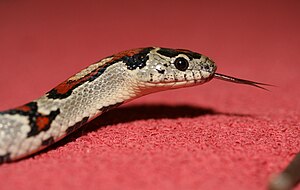Mexican king snake
| Mexican king snake | ||||||||||||
|---|---|---|---|---|---|---|---|---|---|---|---|---|

Lampopeltris mexicana greeri |
||||||||||||
| Systematics | ||||||||||||
|
||||||||||||
| Scientific name | ||||||||||||
| Lampropeltis mexicana | ||||||||||||
| ( Garman , 1884) |
The Mexican king snake or San Luis Potosi king snake ( Lampropeltis mexicana ) is a snake from the adder family (Colubridae). It occurs with three subspecies in northern Mexico and the extreme south of Texas . Molecular biological studies indicate that the Mexican king snake is not a monophyletic species , but a polyphyletic taxon and that the subspecies are probably independent species.
features
Mexican king snakes reach a length of just over a meter. The head with a large eye with a punctiform pupil is only slightly separated from the neck. The color is very variable, on a basic color, which can take on different shades of gray, there are numerous red, white and / or black bordered saddle spots. In front of the short and wide frontal shield are two large prefrontal shields that connect to two small internasal shields . The number of supralabial shields is seven and that of infralabial shields eight to eleven. The back scales are smooth and lie in the middle of the body in 21 to 25, mostly 23 rows. There are 190 to 212 ventral shields , 51 to 65 sub-caudal shields, and an undivided anal shield .
Lampropeltis mexicana mexicana
The nominate form occurs in San Luis Potosi , Guanajuato and Zacatecas at an altitude of up to 1800 meters. It has up to 46 saddle spots, which are more or less square and dark to bright red with a black and therefore white border. There is a Y-shaped spot on the nape of the neck, the belly is light and dark spots. The number of ventral shields is a maximum of 200.
Lampropeltis mexicana greeri
This subspecies occurs in the south of Durango at an altitude of 1,800 to 2,400 meters. The up to 38 saddle spots are black with mostly a red center and a white border and extend to the flanks, the basic color is usually lighter than in the nominate form. The top of the head is gray with black spots. The nape of the neck is elongated with a convex front edge, the belly whitish with scattered black spots.
Lampropeltis mexicana thayeri
This subspecies, which occurs in the south of Nuevo Leon and on the eastern slopes of the Mexican plateau at an altitude of 1200 to 2000 meters, has a highly variable coloration, whereby different variants can occur within one litter. The "Leonis" version has over 28 red saddle spots with a black border, the "Milksnake" version has 24 to 26 such spots on a light background. There are also albinotic and melanotic individuals. The number of ventral shields is over 195.
Way of life
Mexican king snakes are mainly crepuscular and nocturnal and hide under stones and in crevices during the day. Lizards and, to a lesser extent, small mammals serve as prey. After four to five months of hibernation, the mating season lasts from March to early May. The species lays eggs.
swell
- Ludwig Trutnau : Non-toxic snakes, part 2 . 4th edition. Eugen Ulmer GmbH & Co., Stuttgart 2002, ISBN 3-8001-3223-0 .
Individual evidence
- ↑ Robert W. Bryson Jr., Jennifer Pastorini, Frank T. Burbrink, Michael RJ Forstner: A phylogeny of the Lampropeltis mexicana complex (Serpentes: Colubridae) based on mitochondrial DNA sequences suggests evidence for species-level polyphyly within Lampropeltis . In: Molecular Phylogenetics and Evolution . tape 43 , 2007, p. 674–684 (English, full text [PDF]).
Web links
- Lampropeltis mexicana in The Reptile Database
- Lampropeltis mexicana inthe IUCN 2013 Red List of Threatened Species . Posted by: Vazquez Díaz, J. & Quintero Díaz, GE, 2007. Retrieved January 5, 2014.
